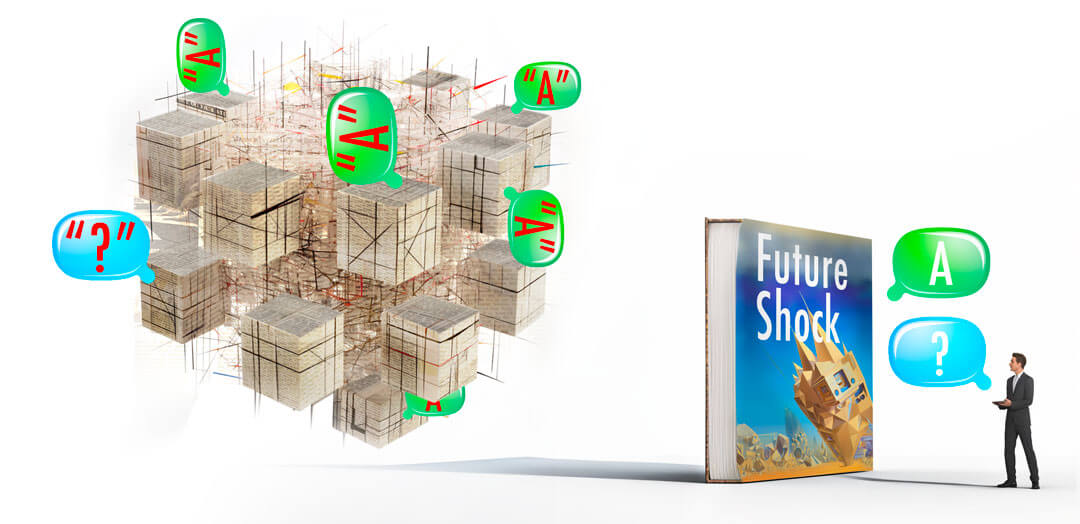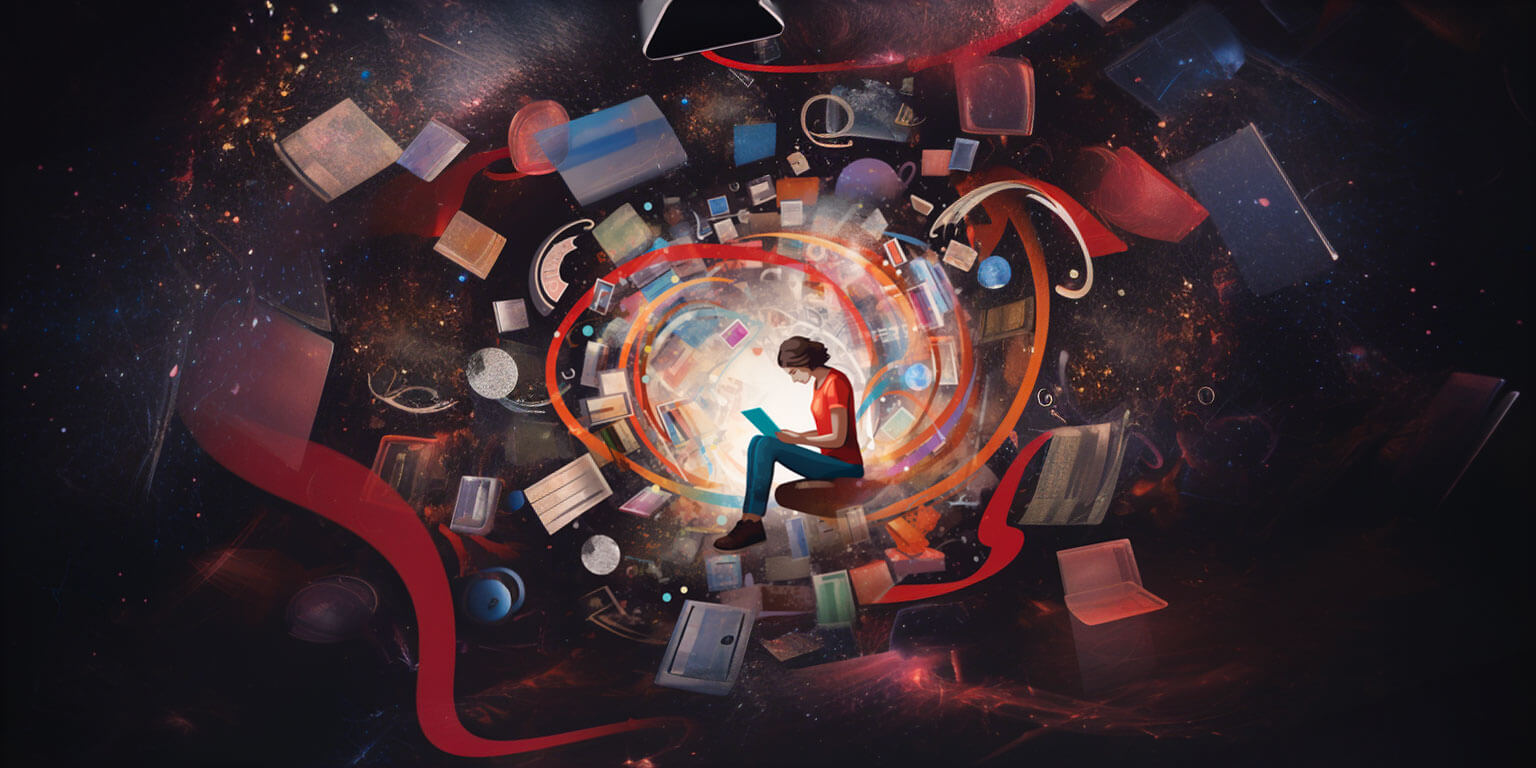Sometimes, the world seems to be changing too quickly. Trusted futurists, Alvin Toffler and Heidi Toffler, warned of a coming “future shock” as people struggle to adapt to a world that moves faster than humanity has evolved to keep-pace with.
“The accelerated rate of change forces individuals to cope with an overload of largely unassimilated new information and experiences. Individuals cannot comprehend the sheer volume of change that is occurring, resulting in dizziness, disorientation and a pervasive feeling of stress.”
The above words were written back in 1970; they exist within text printed on the pulpy pages of a paperback book titled “Future Shock”.
Even 50 years after the writing of “Future Shock”, it’s easy to read the book and become overwhelmed with its succinct, well-reasoned examples of just how fast “modern” society seems to move.
Thanks to advancements in computer processors, the pace of change seems to accelerate with each new technological advancement made by humans. Even though humans haven’t always had computer-assisted changes to cope with, its likely that historic humans have likely always felt pressures to adapt to rapid shifts in their environment, both technological and natural.
Human Adaptation Over Time
Consider a human from 10,000 years ago undergoing a gradual shift in their climate, causing animal migration patterns to change, and affecting their supply of food. This would be akin to a present-day human walking down to the store for groceries, only to find that the store had vanished entirely.

This environmental change, coupled with homo sapiens’ ability to deduce a solution to the problem, determined whether a human adapted to this change, or died, hungry and confused.
Or imagine someone from 1000 years ago dealing with annual taxation, introduced by a new ruling class. As a sustenance farmer in 1,000 A.D. England, you may have a been tending to your field, and then suddenly someone comes up on horseback and tells you “There is a new King for this land, and you are now His subject. And… you owe us $XX already”.
Skipping “ahead” to just 100 years ago, we can consider being alive in the roaring 1920’s. Depending on the continent on which you live, the time period of the 1920’s would seem INCREDIBLY dynamic.
If you’re on Europe in 1920, you’re recovering from a lot of explosions, and territoriality, and nationalism.
If you’re in the USA in 1920, you’ve been dealing with a booming stock market, an under-enforced prohibition of alcohol, and generally just pretending like that things are great.
NOTE: If you’re in other parts of the world, I’m unsure what you’re doing in 1920; my formal education was skewed and biased to only tell me what happened in USA and Europe.

Today, a person who has a smartphone in their hand will have no need to ever act on anything. In essence, a person can tune into the world’s events and continually ride a wave of never-ending-new. With so much information available at any moment, it can be overwhelming to feel that you “know” what do to next with any level of surety.
What does all of this have to do with the book “Future Shock”?
I’ll tell you that I first started reading “Future Shock” while I was riding on a bus through a downtown area. The book was discussing how common it is for a business’s name to change, or it’s location to move. This statement seems obvious to me, as I’ve been born into the time period where such practice is normal.
Then I began to consider a time period prior to the time for which I am alive. I began to think “what would it be like to have a single, unchanging village for my whole life? What kind of opportunities would exist, in a world so relatively static?”
Do I think it’s good or bad that my local grocery store has been remodeled three times in 20 years? While I started thinking these things, I started to resent the fact that ANY such trivialities were occupying space in my thoughts.
It was at that moment I put down the book, “Future Shock”, and decided that it was too true for me to keep reading.
I’d made it about 1/3rd through the book at that point.
I’ve never finished reading the book.
So, I fed the entire book into an Ai named Claude Instant, and I asked it to summarize the important aspects for me, with exact excerpts and context from the original book. I had a back-and-froth with Claude and asked it for comparisons, correct prophesies, incorrect predictions, ect.

I’ve now had a chance to review the important aspects of the book thanks to Ai, and I was able to do so without actually having to immerse myself in that “too true” of a world, and I feel that the resut of this hybrid Ai-human written work will be useful for others to read.
Hence, this book analysis for a book I only read a third of.
Historical Context – “Future Shock” Book
“Future Shock” was published in 1970, which means the ideas within it were bubbling to the surface throughout the social upheavals of the late 1960s.
While “Future Shock” was being written, the Civil-Rights Movement and anti-war protests were frequently shown in news media. Youth counterculture and sexual revolution flourished in the United States, partly as a result of improved methods of birth control for women.
At the same time in the late 60’s, technological innovations like the ARPAnet, an early form of Internet, helped move data back and froth across great distances with incredible speed.
For people of the late 1960’s, the commercialization of jet air travel provided the exact same benefit to the human being, albeit at a less-than-instant rate, but still after than car and train travel.
The husband-and-wife author team of “Future Stock” drew upon this context of perceived rapid change, and they issued a warning about the psychological and social impacts that were due to unfold in the 1970s and far beyond.
The Future Shock book contains many ideas, and some of the ideas have come to pass, and some have not. Below you can read which aspects of Future Shock still resonate today, and which things didn’t quite come to pass as the book predicted…
“Future Shock” Similarities With Current Time
Perceived Rapid “Technological Change”
The pace of technological innovation has only increased since the 1970s. Even back in the 1970’s there were signs that technologies like automation, AI, the Internet were beginning to disrupt industries and transform societies.

In the 50+ years since 1970, computer processing power has increased exponentially, while costs have decreased dramatically. Emerging technologies like autonomous quad-copter drones, 3D printing, augmented reality, and blockchain technology are changing the way we work, communicate, and live.
We Experience “Information Overload”
There is a constant stream of online media that is attempting to communicate a message to us. A single individual is bombarded with an unprecedented amount of information on a daily basis.

People have access to virtually unlimited information through connected devices, but they face a big challenge of filtering out what is relevant and important amidst such a huge amount of data.
Continual “Transience of Relationships”
Future Shock correctly points out the ways in which human relationships, organizations, jobs, and products seem to have a diminishingly shorter lifespan, on average.
A CEO for a company in 1970 had a good chance to keep that position for well over two decades, where as today that CEO is replaced after about 7 years… or sooner if they’re a pizza-company CEO who insists that they should be able to use the N-word.
When it comes to the the actual employees that CEO’s oversee, job-hopping has become more common; many individuals today have multiple jobs, with each job requiring a person to adopt a separate “brain” and “persona” in order to do the job properly.

The gig economy has created a rise in contingent-work arrangements and freelancing, which enables one person to feel that they can undertake 3 or 4 different jobs, nearly concurrently. Whether a person can actually perform these 3 or 4 jobs, is another story entirely.
Product life cycles have shortened, both for technological reasons as well as purely cosmetic justifications for a “new” anything. Customer tastes change at an accelerating pace, since customers are inherently “novelty-seeking humans”.

Thanks to teleconnection technology like smartphone messaging and video conferencing, social relationships are challenged by less geographic stability and proximity. With smartphones and Internet connectivity, humans are free to form meaningful connections with each other, regardless of those humans’ physical proximity to each other.
The “Tele” in telecommunication is Greek for “Far Off”.
Future Shock’s Differences With Current Time
An Actually Faster “Rate of Change”
While rapid change was already occurring in the 1960s, the rate has accelerated tremendously since then due to advances in technology. The number of scientific papers published each year has more than doubled since 1970, which indicates quite a bit of scientific advancement at a societal level.

Smartphones, social media and the Internet have interconnected the world and sped up the flow of information beyond what the authors of “Future Shock” envisioned back in 1970. Emerging technologies like AI, robotics, gene editing and blockchain promise even greater disruption in the coming years.
Increased Diversity of All Things
There are even more choices, options and novelty in today’s world compared to the 1970s. There are over 4 million apps available on the Android and iOS app stores combined. Consumers have an unprecedented level of customization and personalization, and our hyper-specific personalizations are applied to everything from our news and music, to our goods and services.

Diversity and representation of all is increasingly proliferating across media, as corporations and brands start to realize that ALL people are their target market, not just a specific looking customer. This can help to break pre-conceptions that the world is “all one kind of person”.

Thanks to Ai image generation tools, we’re exposed to a greater diversity of humanity than ever before; after all, it’s just as easy to ask for an Ai image of a “white person in a wheel chair wearing a rainbow shirt, with red hair” as it is to ask for “a person standing in a grocery store”.

When it doesn’t cost more to show Person A, or Person Z, compared to Person M, then we’ll start to see a lot more of the alphabet that represents us.
Coping Mechanisms for Rapid Change
Society is in a continual state of improvement, with regard to how it deals with rapid change through better education, social services, technological regulation, etc.
Which group is your group?
To look around a given society, one might think that people seem to have adapted to these changes relatively well. We are unable to see the internal struggle of individuals; loss of meaning, identity crises, social isolation, & political polarization are all way in which technology can plant seeds of doubt in a human.

There is a potential need for even greater systemic change in order to direct technological advancement so that benefits all of society, not just certain groups.
If technology isn’t taught at some basic level to human society, then there will be even greater gaps between the ‘have tech” and “have nots”.
Incorrect Prophesies in Future Shock
“Future Shock” predicted that there would be widespread use of experiential simulation, as a method of pre-adaptation. I suppose, in a way, this was taking the mind-expanding elements of 60’s psychedelic drugs, and applying it to a digital environment. Intriguing though this idea is, it has yet to evince fully in modern society.
 In “Future Shock”, Toffler and her husband envisioned the rise of sophisticated experiential simulations that would allow individuals to “preview” future environments and situations.
In “Future Shock”, Toffler and her husband envisioned the rise of sophisticated experiential simulations that would allow individuals to “preview” future environments and situations.
While virtual reality and simulation technologies have advanced in the last 10 years, they have not been widely adopted for pre-adaptation purposes. If our ability to simulate something progress to where the simulation can make accurate predictions about reality, then this future prediction will start to become reality.
Creation of “Imaginetic Centers”
Imagine a place you could visit and virtually brainstorm preferable futures for yourself. Alvin and Heidi Toffler proposed the establishment of “Imaginetic Centers” where creative people could come together to imagine and explore potential futures. These kinds of groups are nearly a reality in our current age of 2023, but they’re not fully realized just yet.

While some futurist think tanks and organizations like this exist, they have not proliferated on the scale Toffler and co envisioned. The closest thing we have to these “Imaginetic Centers” are online forums and services like Discord, where large groups of relative strangers can gather and share information.
“Social Future Assemblies” for Democratically Defining Goals
The “Future Shock” authors argued for grassroots assemblies where ordinary citizens could participate in defining broad social goals and direction. Some examples of this kind of “direct” participatory democracy initiatives have emerged, such as the Occupy Movement in 2011.

Overall, a system of Representative Democracy has instead prevailed in the United States, and there has been no widespread adoption of the Tofflers’ vision of “social future assemblies.” In the United States, it seems that no particular incentive for a dramatically-different system is being demanded, and thus no meaningful change is occurring in that regard.
Continued Relevance of Future Shock
Despite some predictions which aren’t yet evincing, the book Future Shock remains a thought-provoking read that can help us understand our rapidly changing world. Alvin and Heidi Toffler present well-reasoned concepts for handling “future shock”, transience, and overchoice.
Their book suggests that it is possible to manage change via conscious human action, and they believe that our current world can provide useful frameworks for navigating the turbulence of the next century.

In conclusion, while much has changed since 1970, the underlying dynamism and unpredictability of rapid technological and social change described in Future Shock continues today.
The book “Future Shock” remains relevant as a historical diagnosis of the challenges created by technological acceleration, and as a source of ideas for how we might better adapt to an uncertain future.

This article was written and organized using the Ai Tool called Claude Instant 100K. Using this tool I was able to tell it all about the book Future Shock, in order to have a proper discussion about it. The discussion first involved me talking to Claude, and asking it various questions about the book.
In fact, you can read my conversation here, https://poe.com/s/GvOc73BKDZrLwfKfglY8 – or Click here to download the text transcript in case the link is dead
One thing you can use to determine what’s “Carleton’s” writing, vs what’s “Claude’s” writing; I utilize semicolons, ampersands for list of things, & the Oxford comma.
Suggested Articles:
- “Zen And The Art Of Motorcycle Maintenance” Summary Discover key lessons from “Zen and the Art of Motorcycle Maintenance”: curiosity, finding joy in simplicity, patience, kindness, and helping others.
- The Hive Queen And The Hegemon – An Imagined Book Delve into “The Hive Queen and the Hegemon,” a fictional book imagined within the Enderverse, co-created with Claude Instant AI. Explore themes of unity, war, and leadership.
- One Flew Over Book – An Imagined Perspective Experience “One Flew Over” from a new perspective, written with Claude 3.5 Sonnet 200k. Witness the impact of McMurphy through the eyes of a silent observer.

